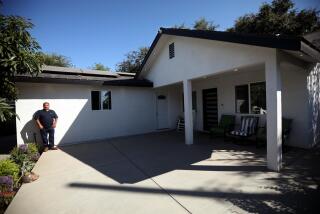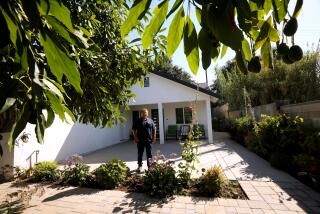Immigration, Births Bolster Local Businesses, Strain City Services : Latinos Turn Southeast Into Booming Port of Entry
Lay minister Dora Tolmasoff surveyed a crowd of 60 parents and children seated in the chilly basement of St. Matthias Church for a baptism orientation class.
“How many of you parents have eight children?” she said in Spanish into a microphone. A few hands went up.
“How many have more than six?” Tolmasoff asked. More hands waved.
“Five or more?” Numerous hands went up. Tolmasoff smiled.
“Congratulations!” she said. “I have six children myself.”
With 70 baptisms every weekend, the Huntington Park church requires attendance at evening baptism classes not only for religious training but also to ensure order at the services.
There is seemingly no end to the supply of babies for such baptisms in the Southeast area, where a cluster of small, crowded cities bordered by East Los Angeles to the north and Compton to the south have some of the highest birthrates in the county and where the population increase far outstripped the county’s average growth rate of 10% between 1978 and 1983.
Population experts see this cluster of Southeast cities, together with East Los Angeles, as a port of entry or “incubator area” for Latinos immigrating to Southern California. The baby boom in the Southeast area stems from the fact that these immigrants are young Latinos who tend to have big families, experts say.
Together, immigration and a high birthrate have created the rapid population growth.
To city officials grappling with day-to-day problems, the dramatic population growth has been a mixed blessing. The growth has brought a rebirth of a kind to cities drained by white flight in the mid-’70s. Many of the new immigrants do not have cars and tend to shop locally, bolstering area businesses, officials said. And the newcomers have rejuvenated churches, service organizations, theaters, nightclubs and restaurants, bringing a new vibrancy to the area.
Strain on Communities
But the burgeoning population has put a strain on communities financially hard-pressed to meet the demand for everything from schools and park services to housing.
“Nobody’s looking at the demographics of what’s happening here and the plan for the future,” said Bell Councilman George Cole. Population density is “taxing the whole superstructure of the cities here,” he said. “To me it presents a real challenge.”
Though population researchers differ on predictions for future growth, the statistics for the past five years show an unmistakable trend.
Huntington Park, Cudahy, Maywood, Bell Gardens, Lynwood and Commerce all placed among the 10 cities in the county with the highest birthrates in 1983, the latest year for which statistics are available. Neighboring South Gate and Bell placed 13th and 18th out of the county’s 83 cities.
Southeast-area population increases--a combination of immigration and births--ranged from 17% in Commerce to an amazing 45% in Maywood between 1978 and 1983.
In Huntington Park, the growth is “causing a rebirth of the whole city” after years of decline in the ‘60s, said Mayor Bill Cunningham. “Our sales tax (income) is at an all-time high because these people stay (and shop) at home, and God love them for that.”
Bustling Shopping Area
On Pacific Boulevard, a shopping area lined with department stores and shops specializing in children’s wear, “it seems like it’s Christmas Eve every Sunday,” Cunningham said.
But cities like Cudahy, where nearly 20,000 people live in about one square mile, have grown poorer as they have grown larger, said Cudahy Councilman John Robertson. “We don’t have the tax base to match the problem. You’re talking about a community with a very low income.”
The rapid population growth in Southeast-area cities would burden the wealthiest of towns. Some examples follow:
- Schools: Most Los Angeles Unified School District schools in the Southeast area, already on a year-round schedule of classes to reduce overcrowding, will reach capacity by June, district officials say.
The district has estimated that by 1992, enrollment will exceed capacity in the area by 4,000 students--even with construction of five elementary schools now on the drawing board. (See related story on Page 4.)
- Housing: Construction of new housing has lagged far behind the population surge. Land is so scarce that to build, the cities must bulldoze, and redevelopment projects often involve relocating low-income residents.
In Maywood, nearly 25,000 people are crowded into 1.2 square miles. The population has grown by 8,000 since 1978, while fewer than 50 new housing units have been built.
“We’ve got houses where people sleep in shifts,” said Maywood Planning Commission member David Rogers. “You rarely see a house that is empty. The majority of units are overcrowded, and people are living in garages.”
- Quality of life: Population growth has put a strain on park use, trash pickup, traffic, hospital maternity wards, even church services. Crowds of people--whether at bus stops, doctors’ offices, supermarkets, check-cashing businesses, post offices or park playgrounds--are a feature of everyday life.
Population researchers have a simple explanation for the high birthrates in the Southeast area: Latinos tend to have large families.
“What’s happening is that the original non-Hispanic white population has left and has been replaced with a largely immigrant Mexican population with considerably higher fertility,” said David Heer, associate director of the Population Research Laboratory at USC. (While Mexicans are a majority, numerous immigrants in the Southeast area come from Cuba, Peru, El Salvador, Nicaragua, Guatemala and Argentina.)
An average of 1.53 children are born to Anglo women in Los Angeles County, while an average of 2.86 children are born to Latina immigrants, Heer said.
Census statistics show that between 1970 and 1980, as the Southeast area of Los Angeles County became a port of entry for Latin American immigrants, the percentage of Latinos soared from 22% to 64% of the population in Bell Gardens, from 27% to 70% in Cudahy, from 68% to 85% in Commerce, from 36% to 81% in Huntington Park, from 18% to 43% in Lynwood, from 35% to 80% in Maywood, from 22% to 63% in Bell and from 17% to 58% in South Gate.
High Fertility Rates
Huntington Park, Cudahy, Maywood, Bell Gardens and Lynwood have placed among the county’s 10 cities with the highest birthrate for at least five years, with Cudahy in second place in 1983. Cudahy registered 33.4 births per thousand, or 78% higher than the county’s average of 18.8, in 1983.
The baby boom in those cities is an “echo effect” of immigration, as young immigrants decide to have children in this country, said Kevin McCarthy, a senior demographer for the Rand Corp.
Just how fast Southeast-area cities will grow over the next 25 years is anybody’s guess.
Arguing that there is no more room for rapid growth, the Southern California Assn. of Governments has predicted only modest increases in population by the year 2010 in Cudahy, Maywood, Bell Gardens, Huntington Park, Lynwood and Commerce.
The county Department of Regional Planning, however, predicts continued rapid population growth from immigration into the Southeast area beyond the year 2000.
‘Incubator Area’
“This is the area that has the cultural and community support base for Hispanics,” said supervising regional planner George Malone. The Southeast area is a port of entry, an “incubator area” where Spanish-speaking immigrants come to get a start in this country, Malone said.
The high birthrates and continuing influx of immigrants, together with the scarcity of land for new construction, add up to a housing crisis in many Southeast-area cities.
Census figures from 1980 show that Cudahy, Maywood and Huntington Park have a higher population density than San Francisco, one of the state’s densest cities.
With vacancy rates from 0% to 5% in many Southeast-area cities, residents double up in apartments and houses, resulting in a ratio of persons-per-household nearly 50% higher than the county average. Garages commonly are converted to housing, and in Huntington Park, building inspectors break up about 20 illegal garage conversions per month.
A major dilemma facing the cities is whether to approve construction of sorely needed schools and housing on available land, or put in commercial development that would bolster city revenues.
Need for Redevelopment
“The only solution for a city like Cudahy is massive redevelopment,” said Councilman Robertson. “And that means packing up some very poor people and moving them to other areas. How do you solve it? . . . You’ve got to have a city with significant resources to handle these things.”
In densely populated Maywood, the city recently destroyed 48 housing units to make way for a commercial shopping center. There are no plans to replace the units.
To find out if the sewers can support more housing in the city, the City Council recently authorized an inspection of the 57-year-old sewer system. The findings will affect developers, as well as homeowners who want to build apartments in their backyards.
“We know that there is a big demand,” said Building and Planning Director Ron Lindsey. “We can put up with a little bit of crowding on the lots, but if your waste and water can’t supply the demand, what are you gaining?”
In Lynwood, where 52,800 residents are squeezed into less than five square miles, only five new apartments were built in 1984, city officials said, pointing out that there is just no place to build.
No major housing has been built in the city for 10 years, said Mayor John Byork.
Pressure on Parks
In other cities, parks have been forced to operate recreational programs all year to accommodate students on vacation from the year-round schedule.
Maywood’s two small parks “are so congested, a lot of people don’t even go,” said Planning Commissioner Rogers.
At Maywood Park, which has the city’s only baseball diamond, hundreds of youngsters are unable to play on Little League teams for lack of space, Rogers said. In the evenings and on weekends, he said, as many as half a dozen baseball and football teams crowd into the five-acre park for practice, with coaches “taking any part of the field they can get.”
Men’s soccer teams frequently push youngsters off the field, and the city “can hardly keep up with park maintenance,” said Vic
Heintzman, assistant director of community services.
Although population growth has meant headaches for city and school officials, it has brought a boom to some Southeast-area businesses.
For example, maternity wards in local hospitals and clinics are full.
Busy Maternity Wards
Doctors at Kaiser Permanente Medical Center in Bellflower, which serves these eight cities and others in the Southeast area, delivered 4,562 babies last year and referred another 250 expectant mothers to other hospitals for lack of space, hospital spokesmen said.
At Mission Hospital in Huntington Park, the obstetrics department is the busiest in the hospital, averaging 100 births per month, said Carmen Avelar, director of public relations.
In an effort to tap into the rising maternity market, St. Francis Medical Center in Lynwood has hired a director of maternal and child health and will spend $300,000 this year to renovate its obstetrics department, said Margaret D’Ambrosia, director of corporate development.
In the retail sector, stores selling children’s apparel have proliferated in such cities as Huntington Park and Bell Gardens. The J.C. Penney store in Huntington Park “does a very strong business in children’s lines,” last year expanding its children’s department by more than 60% to keep up with demand, said store manager Dick Curtis.
Service organizations are flourishing, too.
Scout Organization Grows
The Boy Scouts have increased their membership in Southeast-area cities from 1,700 in 1979 to 2,200 in 1984, said Lloyd Otto, district scout executive. And the Southeast Rio Vista Family YMCA in Huntington Park has grown from 1,500 members five years ago to 3,600 members today, director Ernie Hernandez said.
“We can’t keep up with it,” he said. “The building is not adequate for the number of activities and groups we have.”
In Huntington Park, St. Matthias Church every weekend offers 11 Masses, weds four couples and provides Masses for four quinceaneras (15th-birthday celebrations)--in addition to baptizing 70 children. About 2,500 children are enrolled in catechism classes at the church.
Finally, real estate firms in the area have seen a modest upturn in business from their largely Latino clientele. Jervis Realty, with offices in Maywood and Downey, reports $40 million in sales last year--the firm’s record, said Don Jervis Sr.
Whether the Latino population will continue to grow in Southeast-area cities, bolstering local businesses, lies in the hands of women like Sara Leyva, who cradled a 4-month-old boy at the St. Matthias Church baptism class several weeks ago. On folding chairs in the row next to her sat Leyva’s husband and their other three children, ages 4 to 10. Leyva, a resident of Lynwood, came to the country seven years ago from Mexico.
Would she have any more children?
Leyva shook her head firmly.
“This is it,” she said in Spanish. “I’ve got two of each now, and that’s enough.”
Birthrate, Population Surge in 8 Cities Two decades ago, a cluster of small cities in the Southeast area fell on hard times, victims of white flight and urban decay. But since the mid-1970s, tens of thousands of new residents have replaced the old, as Cudahy, Maywood, Huntington Park, Bell Gardens, Commerce, Lynwood, South Gate and Bell became ports of entry for Latin Americans--stepping-off places akin to New York’s Lower East Side at the turn of the century. The newcomers have restored a vibrancy to the area--buying homes, shopping at local stores and giving birth to thousands of babies. But the hard times are not gone. The cities are hard pressed to keep up with the rising demand for new housing, schools and services. City: Cudahy 1983 Population: 19,682 % Population increase 1978-1983: 18% Birthrate in 1983 per 1,000: 33.4 Rank among L.A. County cities, by ’83 birthrate: 2 Average no. persons in household in 1983: 3.76 % Latino population increase 1970-’80: 159% City: Maywood 1983 Population: 24,545 % Population increase 1978-1983: 45% Birthrate in 1983 per 1,000: 32.3 Rank among L.A. County cities, by ’83 birthrate: 4 Average no. persons in household in 1983: 3.78 % Latino population increase 1970-’80: 129% City: Huntington Park 1983 Population: 52,971 % Population increase 1978-1983: 37% Birthrate in 1983 per 1,000: 30.8 Rank among L.A. County cities, by ’83 birthrate: 7 Average no. persons in household in 1983: 3.56 % Latino population increase 1970-’80: 125% City: Bell Gardens 1983 Population: 37,143 % Population increase 1978-1983: 28% Birthrate in 1983 per 1,000: 29.3 Rank among L.A. County cities, by ’83 birthrate: 8 Average no. persons in household in 1983: 3.91 % Latino population increase 1970-’80: 191% City: Commerce 1983 Population: 12,112 % Population increase 1978-1983: 17% Birthrate in 1983 per 1,000: 29.0 Rank among L.A. County cities, by ’83 birthrate: 9 Average no. persons in household in 1983: 3.75 % Latino population increase 1970-’80: 25% City: Lynwood 1983 Population: 52,845 % Population increase 1978-1983: 35% Birthrate in 1983 per 1,000: 27.9 Rank among L.A. County cities, by ’83 birthrate: 10 Average no. persons in household in 1983: 3.77 % Latino population increase 1970-’80: 139% City: South Gate 1983 Population: 73,373 % Population increase 1978-1983: 22% Birthrate in 1983 per 1,000: 27.1 Rank among L.A. County cities, by ’83 birthrate: 13 Average no. persons in household in 1983: 3.10 % Latino population increase 1970-’80: 241% City: Bell 1983 Population: 27,766 % Population increase 1978-1983: 26% Birthrate in 1983 per 1,000: 24.6 Rank among L.A. County cities, by ’83 birthrate: 18 Average no. persons in household in 1983: 3.19 % Latino population increase 1970-’80: 186% City: Los Angeles County* 1983 Population: 7,807,203 % Population increase 1978-1983: 10% Birthrate in 1983 per 1,000: 18.8 Rank among L.A. County cities, by ’83 birthrate: -- Average no. persons in household in 1983: 2.72 % Latino population increase 1970-’80:56% EB *Includes 83 cities and unincorporated areas. Source: Los Angeles County Department of Health Services and Department of Regional Planning and U.S. Census Bureau.
More to Read
Sign up for Essential California
The most important California stories and recommendations in your inbox every morning.
You may occasionally receive promotional content from the Los Angeles Times.










